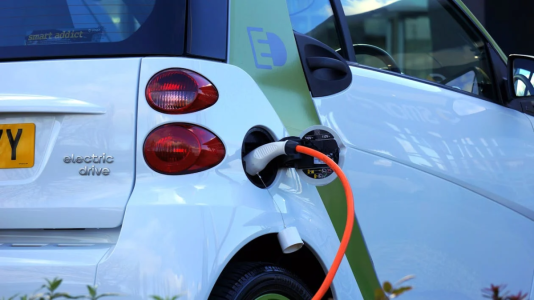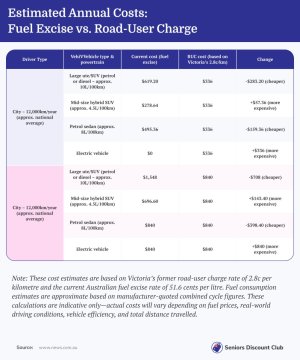Pay at the pump or pay per kilometre—what’s the better deal?
By
Maan
- Replies 0
Electric vehicle drivers could soon face a new cost every time they hit the road—and it may not stop there.
The Federal Government was pushing ahead with plans to introduce a ‘road-user charge’, starting with EV owners.
Some experts believed the scheme could eventually cover all motorists, regardless of what they drive.
Australia’s current road funding relies heavily on a fuel excise of 51.6 cents per litre, paid by petrol and diesel drivers whenever they fill up.
The Government said the $12 billion a year raised from this tax was used to build and maintain the nation’s roads.
However, EV drivers currently contribute nothing to this pool.
The Productivity Commission warned that this funding source was in ‘terminal decline’ as more Australians moved towards low and zero-emission vehicles.
Treasurer Jim Chalmers confirmed the road-user charge was under active consideration as a ‘second term’ reform, meaning it would not come into effect before 2027.
Industry experts pointed to New Zealand’s model, where from 2027 all light vehicles—petrol, diesel, hybrid, and electric—would be charged based on distance travelled and vehicle weight.
If implemented here, the charge would likely replace the fuel excise rather than be added on top.
Under Victoria’s scrapped scheme, EV owners paid 2.8 cents per kilometre, plug-in hybrid owners 2.3 cents, with odometer readings submitted via photos or an app.
Funds from the charge were directed to road maintenance and construction.
Victoria’s program was struck down in court, forcing millions of dollars in refunds.
Some had argued for exemptions or rebates for regional motorists, who typically travel much longer distances.
By contrast, New Zealand’s system has no special discounts for rural drivers, but it does allow exemptions for certain heavy EVs, lightweight EVs under 1,000kg, and vehicles used almost entirely off-road.
Modelling based on Victoria’s former 2.8c/km rate showed a city-based EV driver travelling 12,000km a year would pay $336, compared to nothing under the current system.
Regional EV drivers covering 30,000km annually would face $840 in charges.
For petrol and diesel drivers, the change could mean significant savings—particularly for those in large, fuel-hungry vehicles.
In fact, a large ute or SUV travelling 12,000km a year and using around 10L/100km would pay roughly $336 under the road-user charge, compared to about $619.20 in current fuel excise costs.
Highly efficient hybrids could end up paying more, while inefficient vehicles would benefit most.
Even with the charge, EVs would remain cheaper to run overall than internal combustion engine cars when fuel savings are factored in.
If the idea of paying per kilometre feels like a big shift, it’s worth remembering this isn’t the first time road costs have been up for debate.
There’s another story that looks at how governments are exploring new ways to collect revenue as traditional taxes start to dry up.
It offers a closer look at what could be next on the list of charges drivers face.
Read more: You paid fuel tax for decades—here’s what they’re taxing next

Would a per-kilometre road charge change the way you drive?
The Federal Government was pushing ahead with plans to introduce a ‘road-user charge’, starting with EV owners.
Some experts believed the scheme could eventually cover all motorists, regardless of what they drive.
Australia’s current road funding relies heavily on a fuel excise of 51.6 cents per litre, paid by petrol and diesel drivers whenever they fill up.
The Government said the $12 billion a year raised from this tax was used to build and maintain the nation’s roads.
However, EV drivers currently contribute nothing to this pool.
The Productivity Commission warned that this funding source was in ‘terminal decline’ as more Australians moved towards low and zero-emission vehicles.
Treasurer Jim Chalmers confirmed the road-user charge was under active consideration as a ‘second term’ reform, meaning it would not come into effect before 2027.
Industry experts pointed to New Zealand’s model, where from 2027 all light vehicles—petrol, diesel, hybrid, and electric—would be charged based on distance travelled and vehicle weight.
If implemented here, the charge would likely replace the fuel excise rather than be added on top.
Under Victoria’s scrapped scheme, EV owners paid 2.8 cents per kilometre, plug-in hybrid owners 2.3 cents, with odometer readings submitted via photos or an app.
Funds from the charge were directed to road maintenance and construction.
Victoria’s program was struck down in court, forcing millions of dollars in refunds.
Some had argued for exemptions or rebates for regional motorists, who typically travel much longer distances.
By contrast, New Zealand’s system has no special discounts for rural drivers, but it does allow exemptions for certain heavy EVs, lightweight EVs under 1,000kg, and vehicles used almost entirely off-road.
Modelling based on Victoria’s former 2.8c/km rate showed a city-based EV driver travelling 12,000km a year would pay $336, compared to nothing under the current system.
Regional EV drivers covering 30,000km annually would face $840 in charges.
For petrol and diesel drivers, the change could mean significant savings—particularly for those in large, fuel-hungry vehicles.
In fact, a large ute or SUV travelling 12,000km a year and using around 10L/100km would pay roughly $336 under the road-user charge, compared to about $619.20 in current fuel excise costs.
Highly efficient hybrids could end up paying more, while inefficient vehicles would benefit most.
Even with the charge, EVs would remain cheaper to run overall than internal combustion engine cars when fuel savings are factored in.
If the idea of paying per kilometre feels like a big shift, it’s worth remembering this isn’t the first time road costs have been up for debate.
There’s another story that looks at how governments are exploring new ways to collect revenue as traditional taxes start to dry up.
It offers a closer look at what could be next on the list of charges drivers face.
Read more: You paid fuel tax for decades—here’s what they’re taxing next
Key Takeaways
- The Federal Government was considering a distance-based ‘road-user charge’ for EVs.
- Fuel excise revenue was falling as more motorists switched to electric and low-emission vehicles.
- New Zealand’s national model charges all light vehicles by distance and weight from 2027.
- Some drivers would pay more, others less, depending on fuel efficiency and annual kilometres travelled.
Would a per-kilometre road charge change the way you drive?









